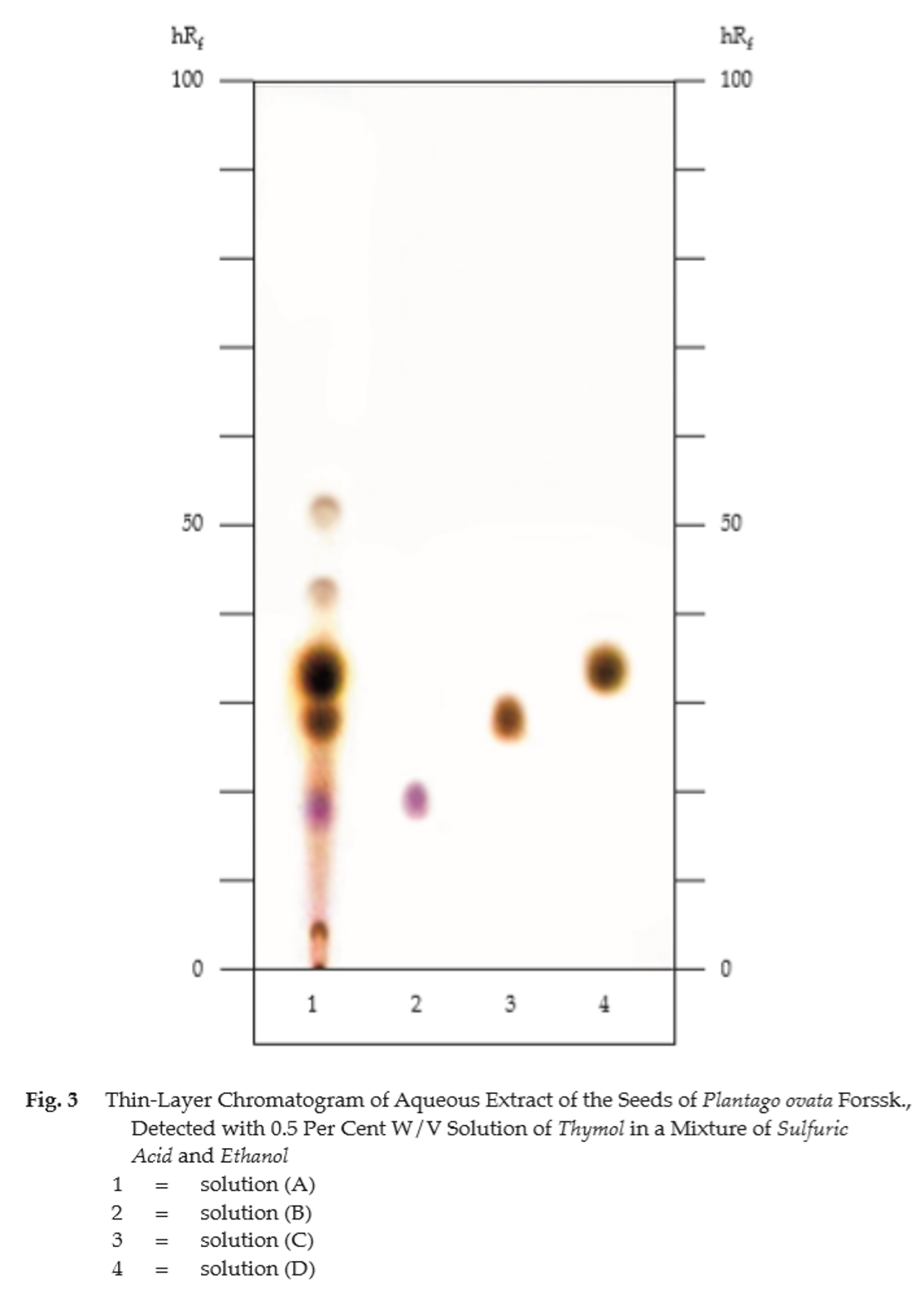ตำรามาตรฐานยาสมุนไพรไทย
Thai Herbal Pharmacopoeia
สำนักยาและวัตถุเสพติด กรมวิทยาศาสตร์การแพทย์ กระทรวงสาธารณสุข
Bureau of Drug and Narcotic, Department of Medical Sciences, Ministry of Public Health(Tinospora crispa (L.) Hook.f. & Thomson)
(Nelumbo nucifera Gaertn.)
(Centella asiatica (L.) Urb.)
(Centella Dry Extract)
(Centella Cream)
(Mesua ferrea L.)
(Piper sarmentosum Roxb.)
(Piper sarmentosum Roxb.)
(Pterocarpus santalinus L. f.)
(Santalum album L.)
(Senna tora (L.) Roxb.)
(Senna alata (L.) Roxb.)
(Senna Alata Tea)
(Piper retrofractum Vahl)
(Myristica fragrans Houtt)
(Andrographis paniculata (Burm. f.) Nees)
(Andrographis Capsules)
(Allium ascalonicum L.)
(Ocimum tenuiflorum L.)
(Curcuma longa L.)
(Turmeric Capsules)
(Turmeric Dry Extract)
(Turmeric Dry Extract Capsules)
(Arcangelisia flava (L.) Merr.)
(Curcuma sp.)
Harrisonia perforata (Blanco) Merr.
(Aristolochia pierrei Lecomte)
(Zingiber officinale Roscoe)
(Ginger Capsules)
(Ginger Tea)
(Cassia fistula L.)
(Nardostachys jatamansi (D. Don) DC.)
(Angelica sinensis (Oliv.) Diels)
Artemisia annua L.
(Ligusticum sinense Oliv. cv. Chuanxiong)
(Neopicrorhiza scrophulariiflora Pennell)
(Atractylodes lancea (Thunb.) DC.)
(Aucklandia lappa Decne)
(Terminalia chebula Retz.)
(Angelica dahurica (Hoffm.) Benth. & Hook. f. ex Franch. & Sav. var. dahurica)
(Kaempferia parviflora Wall. ex Baker)
(Hibiscus sabdariffa L.)
(Roselle Tea)
(Allium sativum L.)
(Zingiber zerumbet (L.) Sm.)
(Wurfbainia testacea (Ridl.) Škorničk.& A. D. Poulsen)
(Cannabis sativa L.)
(Myristica fragrans Houtt)
(Dracaena cochinchinensis (Lour.) S. C. Chen)
(Ficus racemosa L.)
(Hyptis suaveolens (L.) Poit.)
Clerodendrum indicum (L.) Kuntze
(Phyllanthus emblica L.)
(Citrus hystrix DC.)
(Citrus hystrix DC.)
(Areca catechu L.)
(Momordica charantia L.)
Moringa oleifera Lam.
(Aegle marmelos (L.) Corrêa)
(Solanum trilobatum L.)
(Morus alba L.)
Gynostemma pentaphyllum(Thunb.)
Makino
(Clinacanthus nutans (Burm. f.) Lindau)
(Cissus quadrangularis L.)
(Mimusops elengi L.)
(Zingiber montanum (J. König) Link. ex A. Dietr.)
(Piper betle L.)
(Capsicum annuum L.)
(Capsicum Oleoresin)
(Capsicum Gel)
(Piper nigrum L.)
(Piper nigrum L.)
(Eurycoma longifolia Jack)
(Thunbergia laurifolia Lindl.)
(Piper wallichii (Miq.) Hand.-Mazz.)
Senna garrettiana (Craib) H. S. Irwin & Barneby
(Terminalia bellirica (Gaertn.) Roxb.)
(Terminalia chebula Retz.)
(Caesalpinia bonduc (L.) H. Roxb.)
(Tarlmounia elliptica (DC.) H. Rob., S. C. Keeley, Skvaria & R. Chan)
(Hog Creeper Vine Dry Extract Capsiles)
(Hog Creeper Vine Dry Extract)
(Brachypterum scandens (Roxb.) Miq.)
(Lepidium sativum L.)
(Nigella sativa L.)
(Cuminum cyminum L.)
(Foeniculum vulgare Mill.)
(Plantago ovata Forssk.)
(Pimpinella anisum L.)
(Carum carvi L.)
(Anethum graveolens L.)
(Trachyspermum ammi (L.) Sprague)
Albizia procera (Roxb.) Benth.
(Acorus calamus L.)
(Tiliacora triandra (Colebr.) Diels)
Cyanthillium cinereum (L.) H. Rob.
(Orthosiphon aristatus (Blume) Miq.)
Murdannia loriformis (Hassk.) R. S. Rao & Kammathy
(Capparis micracantha DC.)
(Chrysopogon zizanioides (L.) Roberty)
(Cyperus rotundus L.)
(Cannabis sativa L.)
(Syzygium aromaticum (L.) Merr. & L. M. Perry)
(Boesenbergia rotunda (L.) Mansf.)
(Acanthus ebracteatus Vahl)
(Acanthus ilicifolius L.)
(Kaempferia galanga L.)
(Curcuma comosa Roxb.)
Betula alnoides Buch.-Ham. ex D. Don
Cannabis sativa L.
Carthamus tinctorius L
Mitragyna speciosa (Korth.) Havil
Mallotus repandus (Rottler) Müll. Arg
Azadirachta indica A. Juss. var. siamensis Valeton
Azadirachta indica A. Juss. var. siamensis Valeton
Punica granatum L.
Rhinacanthus nasutus (L.) Kurz
Baliospermum solanifolium (Burm.) Suresh
Curcuma aeruginosa Roxb
Boesenbergia kingii Mood & L. M. Prince
Senegalia rugata (Lam.) Britton & Rose
Acacia concinna (Willd.) DC.
Senegalia rugata (Lam.) Britton & Rose
Acacia concinna (Willd.) DC.
Senna alexandriana Mill. var. alexandriana
Cassia acutifolia Delile, Cassia angustifolia Vahl
Butea superba Roxb. ex Willd.
[Plaso superba (Roxb. ex Willd.) Kuntze, Rudolphia superba (Roxb. ex Willd.) Poir.
Pueraria candollei Graham
ex Benth. var. mirifica (Airy Shaw & Suvat.) Niyomdham
Streblus asper Lour.
Suregada multiflora (A. Juss.) Baill. (Gelonium
multiflorum A. Juss.
Ispaghula Seed is the dried ripe seed of Plantago ovata Forssk. (P. ispaghula Roxb. ex Fleming) (Family Plantaginaceae), Herbarium Specimen Number: BK 50463, Crude Drug Number: DMSc 435.
Constituents Ispaghula Seed contains mucilage consisting mainly of arabinoxylans. It also contains aucubin, triterpenes, sterols, fixed oil, etc.
Description of the plant (Figs. 1a, 1b) Herb annual or biennial, stemless or subcaulescent, sparsely or thickly villous, up to 30 cm tall. Leaves radical, narrow-linear or filiform, finely acuminate, 7 to 22 cm long, usually 3-nerved, entire or distantly toothed. Scape axillary, longer or shorter than the leaves, glabrous or pubescent; spike ovoid or cylindrical, up to 4 cm long; bract with broad scarious margin, ovate-oblong, obtuse, glabrous. Flower small, greenish to white; sepals 4, imbricate in bud, persistent, ovate to elliptic, glabrous or pubescent; corolla, salver-shaped, scarious, lobes 4, imbricate in bud, corolla lobes rounded concave obtuse; stamens 4, exserted, filament, persistent, anther large, pendulous, versatile; ovary superior, 2-celled, ovule 1, basal in each cell. Fruit capsule, ovoid, membranous, 2-celled, circumscissile; cell 1-seeded.
Description Odour, slight; taste, bland and very mucilaginous.
Macroscopical (Figs.1a, 1b) Boat-shaped, 2.5 to 3.2 mm long, 1.2 to 1.6 mm wide, colour variable, but usually pale greyish brown with a pinkish tinge, dull and hard; on the convex surface a central, glossy reddish brown, elongated oval spot; the concave surface deeply grooved with the hilum a brown spot in the centre of the hollow, more or less covered with a whitish membrane. The seed coat swells in water and the seed becomes enveloped with a thick layer of translucent and colourless mucilage.
Microscopical (Figs.2a,2b, 2c) Transverse section of the seed cut through the cotyledon region shows seed coat, endosperm and cotyledon. The outer layer of seed coat, large, rectangular, mucilaginous epidermal cells; the cells rapidly swelling in water, the outer walls bursting and, liberating numerous finger-like processes of mucilage, occasionally containing starch granules. The inner layer of seed coat, brownish tangentially elongated cells. Endosperm, thick-walled, polygonal cells with numerous large, very conspicuous pits, containing aleurone grains and oil globules. Cotyledons, thin-walled cells containing aleurone grains and oil globules.
Ispaghula Seed in powder possesses the diagnostic microscopical characters of the unground dru
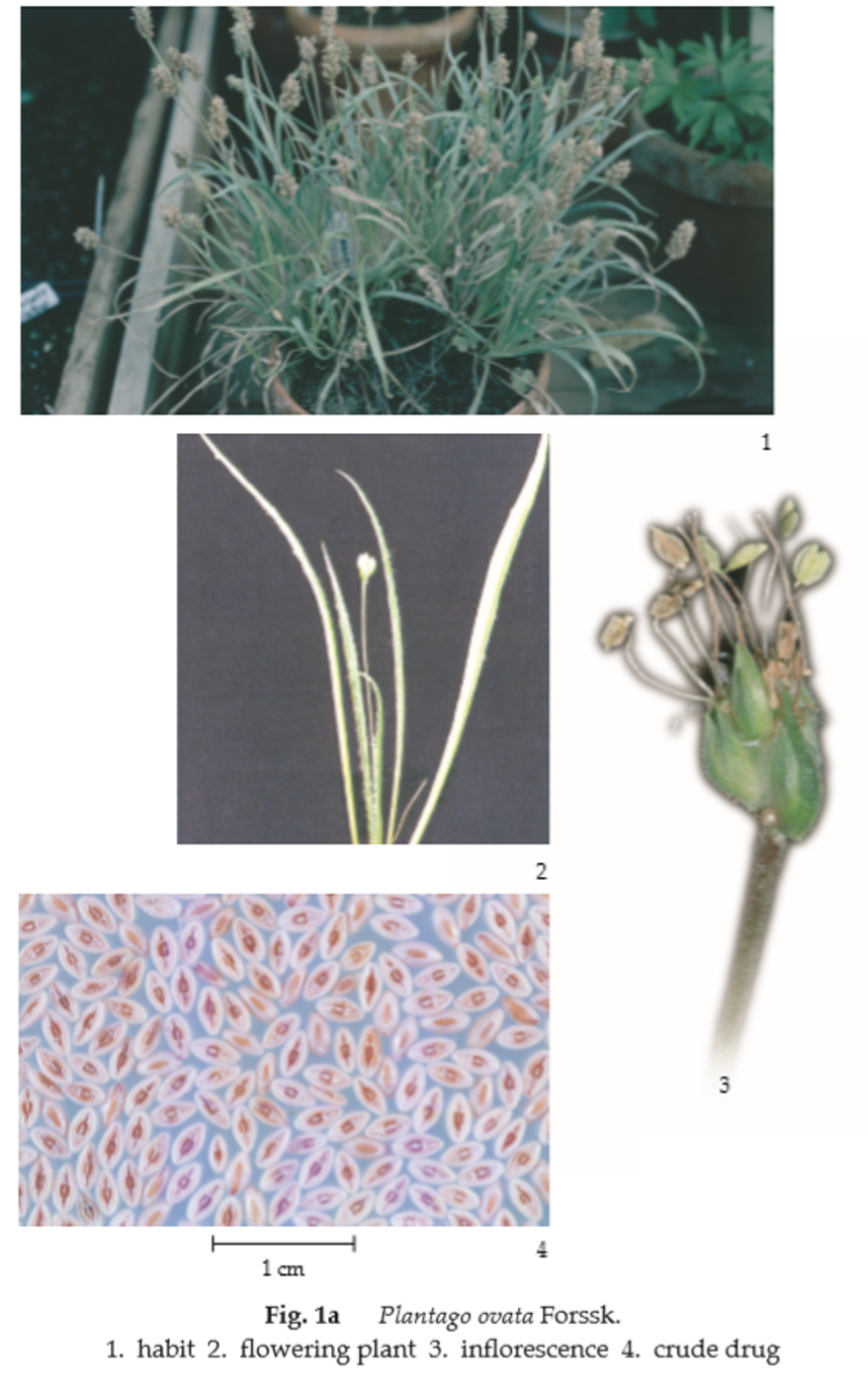
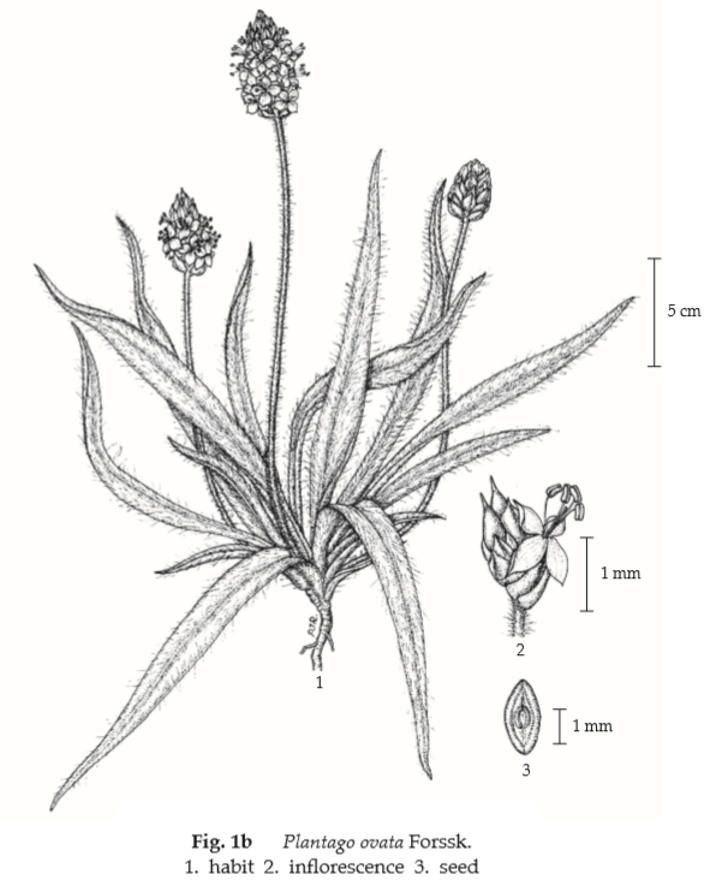
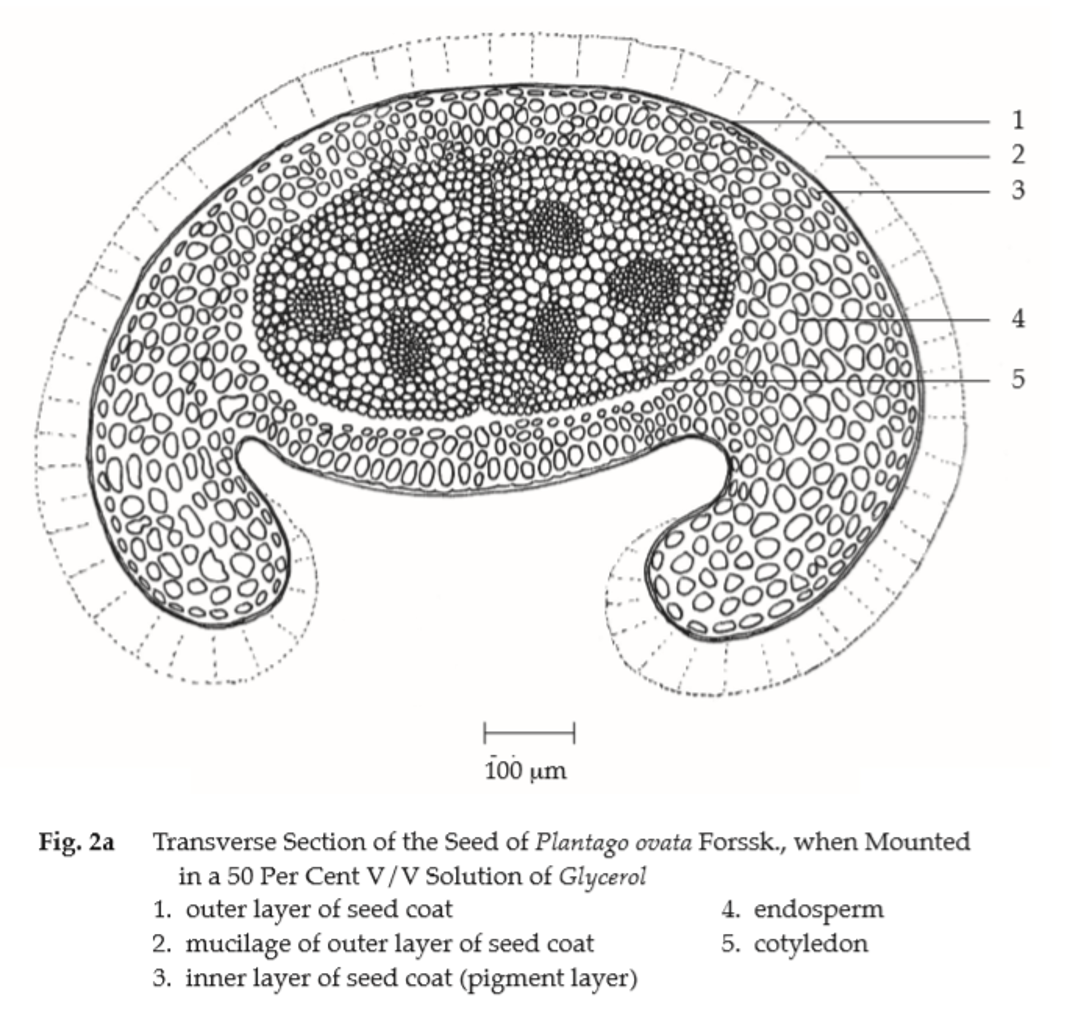
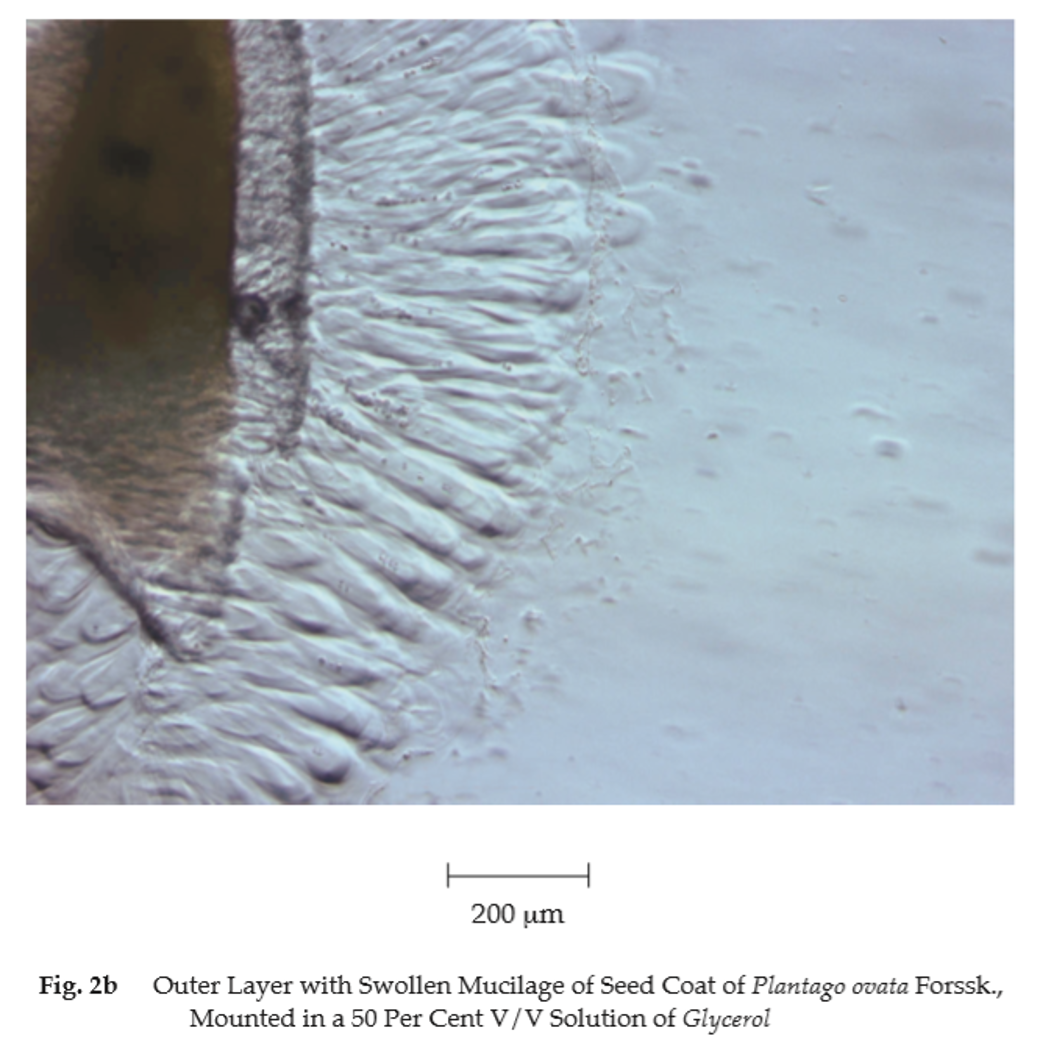
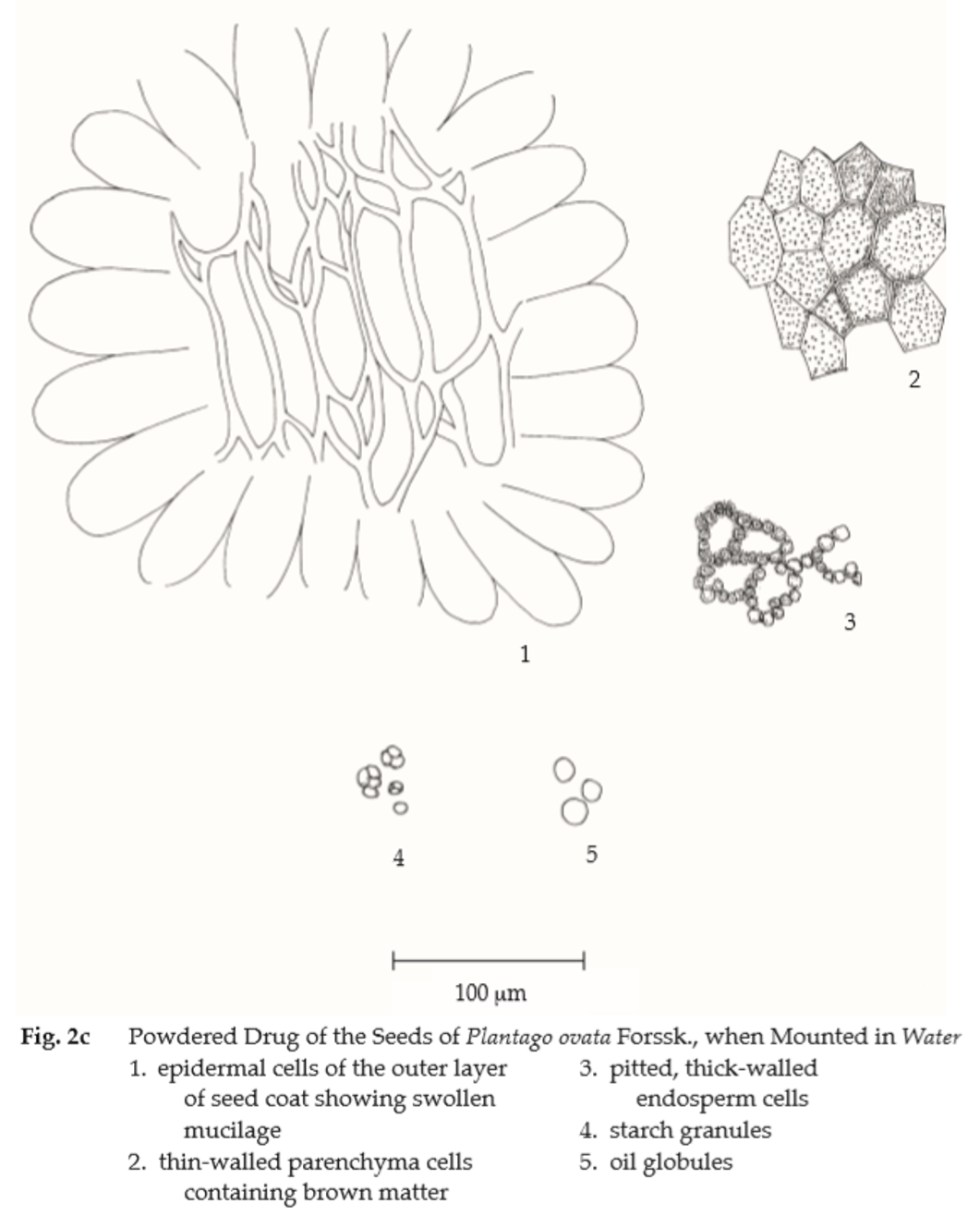
Contra-indication It is contra-indicated in cases of intestinal obstruction.
Warning Pre-swollen seeds should always be taken with plenty of fluid to avoid esophageal obstruction or fecal impaction.
Additional information It is commonly used with other herbal drugs in Thai traditional herbal preparations.
Packaging and storage Ispaghula Seed shall be kept in well-closed containers, protected from light, and stored in a dry place.
Identification
A. Shake 100 mg of the sample, in No. 355 powder with 3 mL of water, allow to stand for 30 minutes and filter. To the filtrate, add 3 mL of dilute hydrochloric acid, boil for 1 minute, cool, and neutralize with sodium hydroxide TS. Add 1 mL of potassium cupri-tartrate TS and heat on a water-bath: a brick-red precipitate is produced.
B. Carry out the test as described in the “Thin-Layer Chromatography” (Appendix 3.1), using silica gel G as the coating substance and a mixture of 85 volumes of acetonitrile and 15 volumes of water as the mobile phase. Apply separately to the plate, 2 μL each of the following solutions. Prepare solution (A) by transferring 50 mg of the sample, in No. 355 powder, to a thick-walled centrifuge tube. Add 2 mL of a 23.0 per cent w/v solution of trifluoroacetic acid and shake vigorously. Stopper the test-tube and heat the mixture at 100° for about 1 hour. Centrifuge for 5 minutes, transfer the clear supernatant liquid into a 50-mL round-bottomed flask, add 10 mL of water, and evaporate again to dryness under reduced pressure at a temperature not exceeding 60°. Dissolve the residue in 10 mL of water and evaporate again to dryness under reduced pressure at a temperature not exceeding 60°. Dissolve the residue in 2 mL of methanol. For solution (B), dissolve 10 mg of galactose in a few drops of water and dilute with methanol to 5.0 ml. For solution (C), dissolve 10 mg of arabinose in a few drops of water and dilute with methanol to 5.0 ml. For solution (D), dissolve 10 mg of xylose in a few drops of water and dilute with methanol to 5.0 ml. After removal of the plate, allow it to dry in air. Spray the plate with a 0.5 per cent w/v solution of thymol in a mixture of 5 ml of sulfuric acid and 95 ml of ethanol, and heat at 130° for about 10 minutes. The chromatogram obtained from solution (A) shows a pink spot (hRf value 18 to 21), a pinkish brown spot (hRf value 30 to 32) and a brown spot (hRf value 34 to 38) corresponding to the galactose, the arabinose and the xylose spots from solutions (B), (C) and (D), respectively. Other spots are brownish yellow (Table 1); see also Fig. 3.
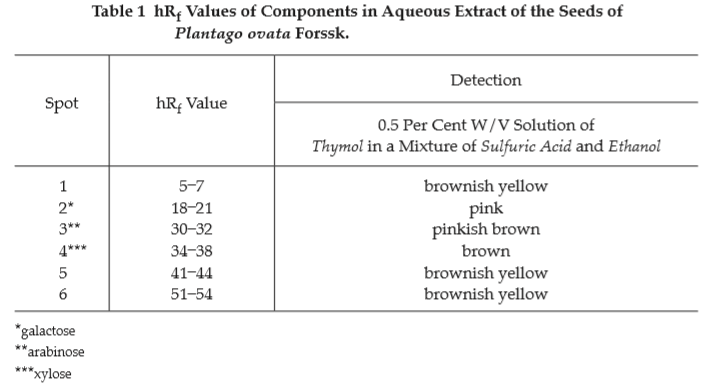
Losson drying Not more than 12.0 per cent w/w after drying at 105° to constant weight (Appendix 4.15).
Foreign matter Not more than 3.0 per cent w/w (Appendix 7.2).
Acid-insoluble ash Not more than 1.0 per cent w/w (Appendix 7.6).
Total ash Of the unground Ispaghula Seed, not more than 3.0 per cent w/w (Appendix 7.7).
Swelling index Not less than 9, when determined by the following method.
In a 25-mL ground-glass stoppered cylinder graduated over a height of 125±5 mm in 0.5-mL divisions, place 1 g of Ispaghula Seed, accurately weighed, moisten it with 1.0 mL of ethanol, add 25 mL of water and close the cylinder. Shake vigorously every 10 minutes for 1 hour. Allow to stand for 3 hours. At 90 minutes after the beginning of the test, release any large volume of liquid retained in the layer of the Seed and any particles of the Seed floating at the surface of the liquid by rotating the cylinder about a vertical axis. Measure the volume occupied by the Seed, including any adhering mucilage. Carry out three tests at the same time. The swelling index is given by the mean of the three tests.
Dose Adults: 5 to 10 g three times a day.
Children: 3 g three times a day.
Seeds shall be soaked in warm water for about 3 hours or until completely swollen before taking.
